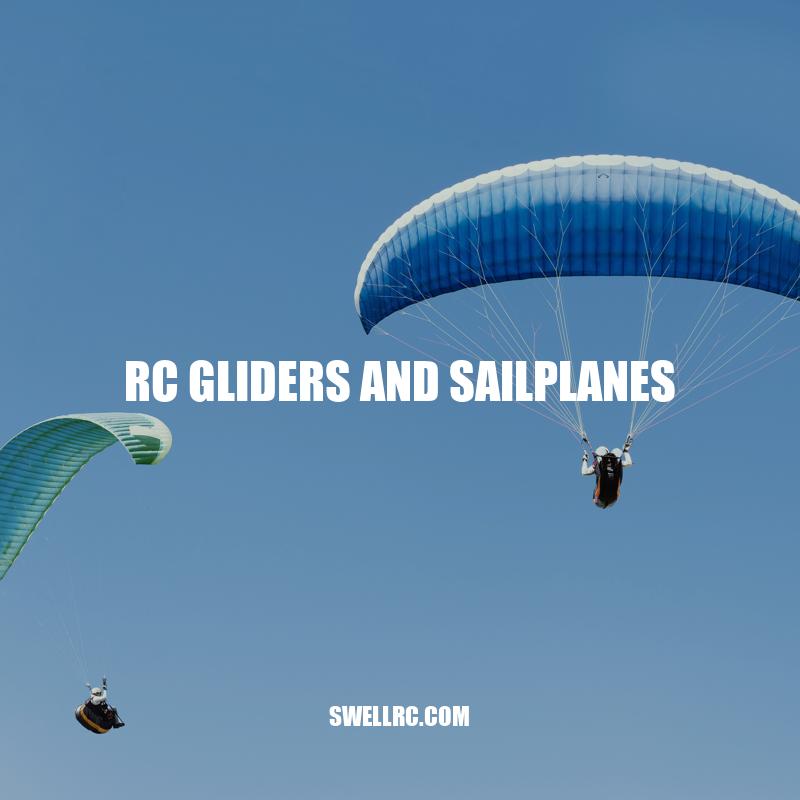Guide to RC Gliders and Sailplanes: Building, Flying and Maintaining
The world of RC gliders and sailplanes is a fascinating hobby that can be enjoyed by enthusiasts of all ages. This type of RC aircraft involves lightweight and streamlined designs that rely on wind and thermal currents to stay aloft. The absence of a motor gives the pilot a sense of connection to the glider, making the experience more rewarding. There are different types of RC gliders and sailplanes, ranging from simple gliders to advanced competition-level models. Building a glider from scratch or buying a ready-made kit is a significant part of this hobby that requires patience and attention to detail. Similarly, flying a glider requires adequate training and experience to perform various maneuvers and patterns in the sky. Joining a local flying club is an excellent way to learn from experienced pilots, meet new people, and develop your skills. Maintaining your glider is also crucial for optimal performance and extending its lifespan. Regular inspection, cleaning, and replacement of worn-out parts are essential to ensure a safe and enjoyable flying experience. Whether you are a beginner or an experienced pilot, RC gliders and sailplanes are a thrilling and rewarding hobby that offers satisfaction and enjoyment.
Types of RC Gliders and Sailplanes
RC gliders and sailplanes come in many different types and models, each with unique features and designs. Here are some of the most popular types of gliders:
- RES Gliders: Also known as Rudder-Elevator-Spoiler gliders, these are simple to fly and beginner-friendly.
- DLG Gliders: Discus Launch Gliders are designed to be launched with a hand toss and can stay in the air for several minutes.
- F3J Sailplanes: These are advanced-level gliders used in competitions and require expert piloting skills to maneuver.
- F5J Electric Gliders: Powered by electric motors, these gliders can stay in the air for extended periods and are perfect for long-distance flying.
No matter what type of glider you choose, it’s essential to get the right equipment for your needs. Some of the necessary items include:
- Transmitter: This is the device used to communicate with your glider during flight.
- Charger: You’ll need a charger to ensure your batteries are fully charged before flying.
- Batteries: Your glider will need a battery to power its electronic components.
- Tools: A set of basic tools, such as screwdrivers, pliers, and a knife, will come in handy when building or maintaining your glider.
If you are interested in purchasing an RC glider or sailplane, there are many websites and stores where you can find them. Some popular online stores include Tower Hobbies and Horizon Hobby, which offer a wide range of models for beginners and experts alike. You can also check out online forums and groups dedicated to RC gliders and sailplanes for advice, tips, and product recommendations.
What are some necessary items for flying RC gliders and sailplanes?
Flying RC gliders and sailplanes is an exciting and rewarding hobby. However, before you take to the skies, it’s important to ensure that you have all the necessary items for a safe and enjoyable experience.
First and foremost, a reliable RC transmitter and receiver are essential. These should feature multiple channels for controlling various aspects of your glider, such as ailerons, flaps, or spoilers. You’ll also need a battery pack to power your RC receiver and servos.
Another important item is a launch device. Depending on the type of glider you’re flying, this may include a bungee system, a winch, or a tow plane. In addition, you’ll want to invest in a quality set of glider wings, as well as any necessary replacement parts.
To protect your glider during transport, consider purchasing a specially designed carrying case or bag. This will help keep your glider safe from scratches, dents, and other damage.
Finally, it’s worth investing in some helpful tools and accessories, such as a digital voltmeter, a set of screwdrivers, and spare propellers or blades. These will come in handy for routine maintenance, repairs, and adjustments.
By investing in the necessary items and taking proper precautions, you can safely enjoy the exhilaration of RC glider and sailplane flying.
RC gliders and sailplanes offer a rewarding and challenging experience for hobbyists. Building your own glider requires careful consideration and attention to detail. Selecting the right model, tools, and equipment is crucial to your success.
When it comes to choosing a model, it is important to select one that matches your skill level and flying style. Beginners should start with simple models that have fewer complex parts. Experienced glider enthusiasts can try more complicated models that require more advanced assembly techniques.
To assemble your glider, ensure that you have all of the necessary tools and equipment. Essential items include a hot glue gun, sandpaper, hobby knife, and wire cutters. Following the instructions that come with your kit, take your time and complete each step accurately to avoid errors during assembly.
Maintaining your glider is critical to its long-term success. After each flight, inspect the wing and tail surfaces, control surfaces, and fuselage for any damage such as cracks or breaks. Clean your glider with a soft-bristled brush or a cloth to remove dirt and debris from its surfaces. Replace any worn or damaged parts immediately to prevent accidents during flight. Store your glider in a dry, cool place to protect it from moisture or heat damage.
If you are interested in designing your own glider, there are several options to consider. You could use computer-aided design (CAD) software to create a custom model. Alternatively, you could explore 3D printing to construct a unique design. Online tutorials and forums can be invaluable resources for getting started with designing your gliders.
Some common tools and equipment you may need during the building process include a hot glue gun, sandpaper, hobby knife, and wire cutters. Brands such as Hot Glue Guns, Sandpaper, and Hobby Knife offer a wide range of products to suit your needs.
In conclusion, building and maintaining an RC glider or sailplane can be a challenging and satisfying experience for hobbyists across all skill levels. Selecting the right glider, tools, and equipment is critical for success. Maintaining your glider and exploring design options using CAD software or 3D printing can open up new possibilities for enthusiasts.
What are some common tools and equipment needed when building an RC glider or sailplane?
When it comes to building an RC glider or sailplane, having the right tools and equipment is essential for a successful and enjoyable project. Here’s a rundown of some of the common tools and equipment needed:
1. Glue: The most commonly used glue for building RC gliders and sailplanes is CA (cyanoacrylate) glue. It dries quickly and maintains a strong hold, making it ideal for use on delicate model aircraft structures.
2. Cutting tools: A variety of cutting tools are necessary for RC glider building, including hobby knives, scissors, wire cutters, and pliers. A good set of precision screwdrivers is also useful.
3. Sandpaper: Sandpaper is necessary for smoothing out rough edges and achieving a perfect finish on your model aircraft.
4. Building board: A flat, sturdy building board is essential for creating a level work surface and maintaining the structural integrity of your RC glider or sailplane.
5. Balsa wood: Balsa wood is the most commonly used material for constructing RC gliders and sailplanes due to its strength and light weight.
6. Carbon fiber: Carbon fiber is a strong, lightweight material used for reinforcing the wings and other structural components of your model aircraft.
7. Covering material: A variety of covering materials can be used to cover and protect the wings of your RC glider or sailplane, including heat-shrinkable plastic, tissue paper, and film covering.
By having these essential tools and equipment on hand, you’ll be well on your way to building a model aircraft that will soar through the skies with ease and precision.
Flying Your RC Gliders and Sailplanes
Flying an RC glider or sailplane can be an exhilarating experience, but it requires proper skills and techniques. Here are a few things to keep in mind when flying your glider:
- Weather conditions: Check the weather forecast and avoid flying in high winds or rain. Calm days with low wind currents are ideal for flying.
- Choose the location: Choose an open space such as a park or a field without any obstacles or trees. Avoid flying in built-up areas or near airports.
- Pre-flight check: Do a pre-flight check by inspecting the glider for any damage or loose parts.
- Launch: You can launch your glider by either hand tossing, using a bungee, or a winch. Decide on the launch method based on your skill level and the model you’re flying.
- Basic maneuvers: Start with basic maneuvers such as climbing, descending, and turning. Learn how to control the glider’s speed and altitude.
- Advanced maneuvers: Once you master basic maneuvers, try more advanced ones such as loops and rolls, but do so with caution.
- Emergency landing: In case of an emergency, try to land the glider safely. Look for a flat and clear area to land and avoid obstacles or people.
Joining a flying club is an excellent way to gain experience and knowledge in flying RC gliders and sailplanes. You can learn from experienced pilots, attend training sessions, and participate in events. Also, many websites provide resources such as flying guides, tutorials, and forums that can help you improve your flying techniques.
If you’re new to the hobby and want to learn how to fly an RC glider, consider buying a beginner-friendly model such as the HobbyZone Duet RTF. This model comes with a 2.4GHz transmitter, batteries, charger, and is easy to fly and control.
Keywords: flying your glider, weather conditions, pre-flight check, beginner-friendly models, flying club, training sessions, resources.
‘What are some beginner-friendly models for flying RC gliders’?
When it comes to flying RC gliders, getting started can seem intimidating – after all, there are plenty of models out there that are designed for experienced pilots. Fortunately, there are also several beginner-friendly models that can help new glider enthusiasts get comfortable with the basics of flying.
One great option for beginners is the HobbyZone Mini Apprentice S. This plane is specifically designed for novice pilots and includes features like a SAFE technology, which helps keep it stable and balanced in the air. It’s also affordable and easy to assemble, making it a great choice for anyone who wants to get started with gliding without breaking the bank.
Another beginner-friendly option is the E-flite UMX Radian. This model is small enough to fly indoors, but powerful enough to take on outdoor flights as well. With a lightweight design and responsive controls, it’s a great choice for anyone who wants to get comfortable with gliding and learn the basics of RC flight.
Of course, these are just a few examples – there are plenty of other beginner-friendly models out there that can help new pilots get started with gliding. Whether you’re interested in indoor or outdoor flying, there’s sure to be a model out there that’s perfect for you!
Maintenance Tips for Your RC Gliders and Sailplanes
Proper maintenance is crucial for ensuring that your RC gliders and sailplanes perform well and last longer. Here are a few maintenance tips to keep in mind:
- Inspect for damage: After each flight, inspect your glider for any damages such as cracks, dents, or loose parts that need to be repaired.
- Clean regularly: Use a soft cloth or brush to clean the glider’s surface and remove any dirt, debris, or dust. Avoid using harsh chemicals that can damage the glider’s surface.
- Storage: Store your glider in a dry and cool place and use a protective cover to prevent dust and insects from getting inside.
- Battery maintenance: Keep the batteries charged and stored correctly. Follow the manufacturer’s instructions for charging and storing the batteries.
- Replace parts: Replace any worn-out or damaged parts such as servos, batteries, or motors to ensure optimal performance.
There are many websites and forums where you can find helpful tips and advice on maintaining RC gliders and sailplanes. You can also find spare parts, accessories, and tools that can help you with maintenance and repairs.
For example, MotionRC is a popular website that offers a wide range of RC gliders, sailplanes, and spare parts. They also provide tips and advice on how to maintain and repair your RC glider and have a customer support team that can help you with any questions or issues.
Keywords: maintenance tips, inspect for damage, clean regularly, battery maintenance, spare parts, customer support, RC gliders, sailplanes.
‘Where can I find spare parts and accessories for RC gliders and sailplanes’?
If you are looking to find spare parts and accessories for your RC gliders and sailplanes, you’re in luck! There are plenty of hobby shops and online retailers that carry a variety of parts and accessories, specifically for RC gliders and sailplanes. In fact, many of these shops specialize in RC gliders and sailplanes, meaning you’ll find a plethora of options and advice in one spot.
One option is to check out your local hobby shop. They may have a selection of parts and accessories in stock, and can usually order anything they don’t carry. Plus, you’ll be able to chat with their sales associates and get their expert opinion on which parts you may need.
Another option is to browse online for RC glider and sailplane retailers. Not only will you find a larger selection of parts and accessories online, but you’ll also be able to compare prices and read customer reviews. Some top online retailers include HobbyKing, Tower Hobbies, and Horizon Hobby.
It’s worth noting that some manufacturers also sell spare parts and accessories directly from their websites. So, if you know the brand of your RC glider or sailplane, be sure to check out their website for any parts or accessories you may need.
No matter where you choose to shop, it’s important to have an idea of the type of part or accessory you need. This will help you narrow down your search and ensure that you’re purchasing the correct item. Consider reaching out to forums or online communities for RC gliders and sailplanes for advice on which parts may be needed for specific models.
With a little bit of research and shopping around, you’ll be able to find the spare parts and accessories you need to get your RC glider or sailplane back in tip-top shape.
Conclusion
RC gliders and sailplanes are an exciting and rewarding hobby for people who love flying and remote-controlled vehicles. With a range of models to choose from, you can find the perfect RC glider or sailplane that suits your interests and skill level.
From building your glider to flying it in the sky, RC gliders and sailplanes offer endless possibilities for fun and satisfaction. Remember to follow the tips for maintenance and repair to keep your glider in top condition and ensure optimal performance.
Whether you fly solo or join a local flying club, RC gliders and sailplanes offer a sense of accomplishment and community among enthusiasts. So, get ready to soar high with your RC glider and sailplane and explore the endless possibilities of this exciting hobby!
Keywords: RC hobby, maintenance, sense of accomplishment, community.



